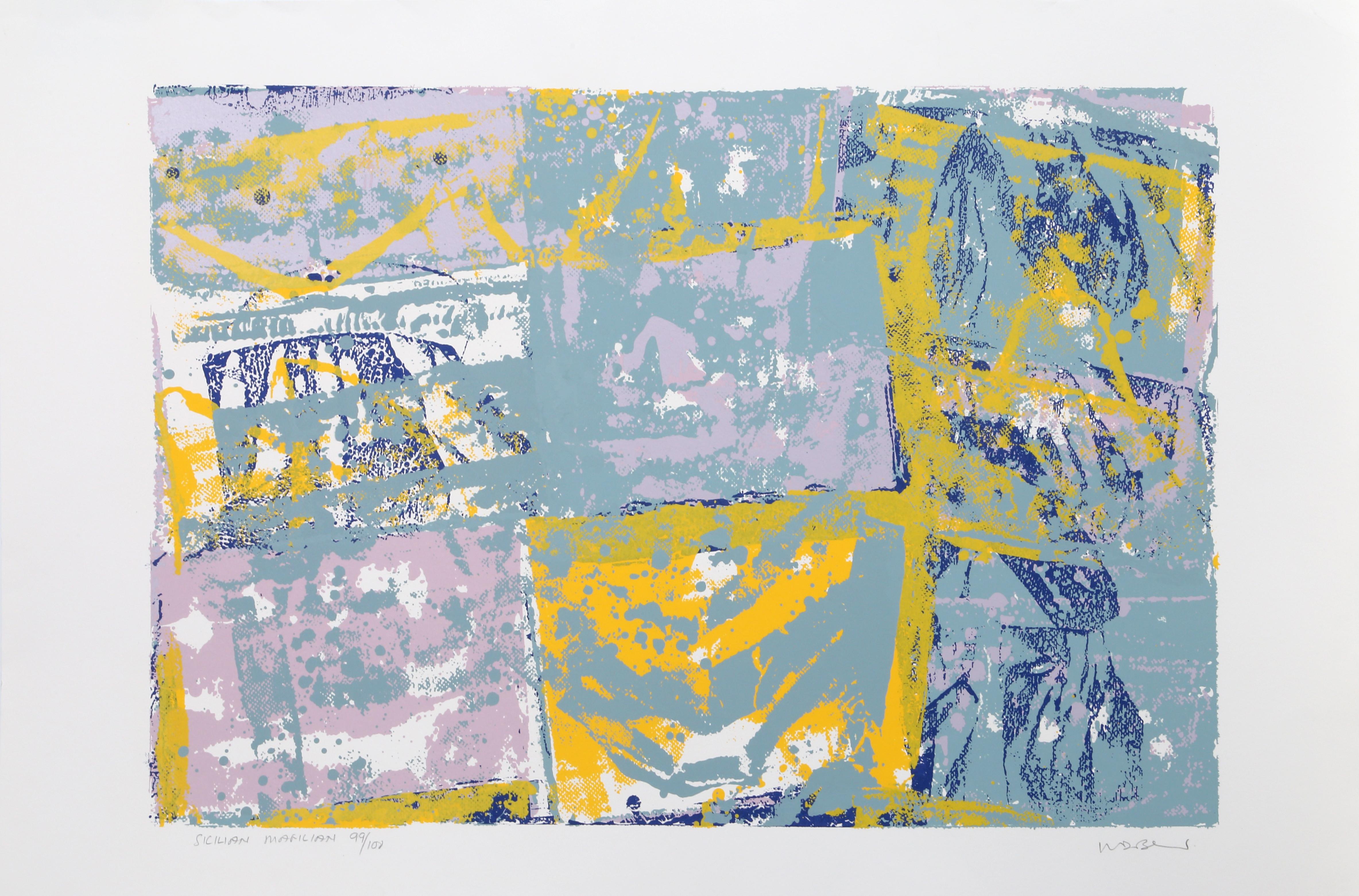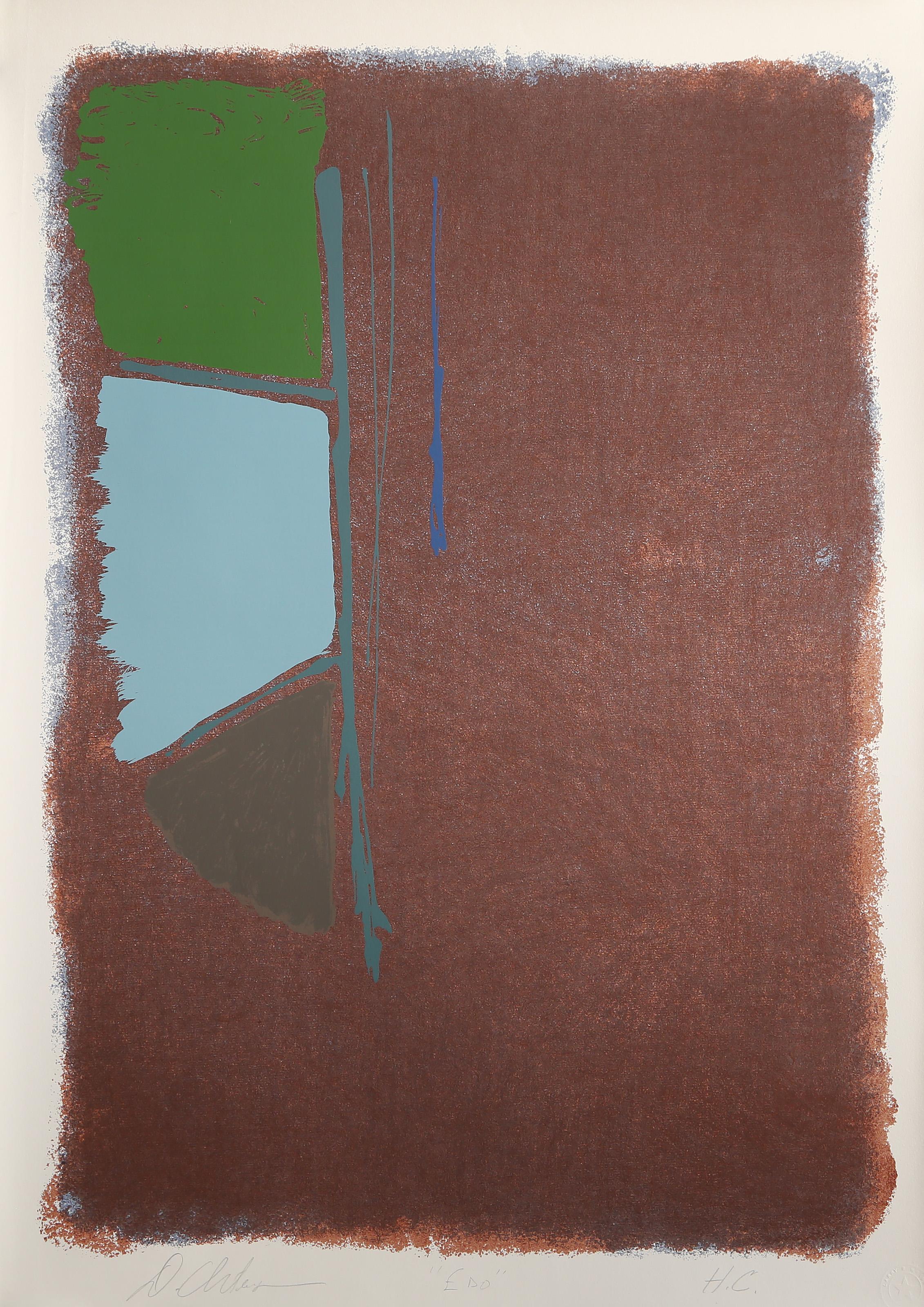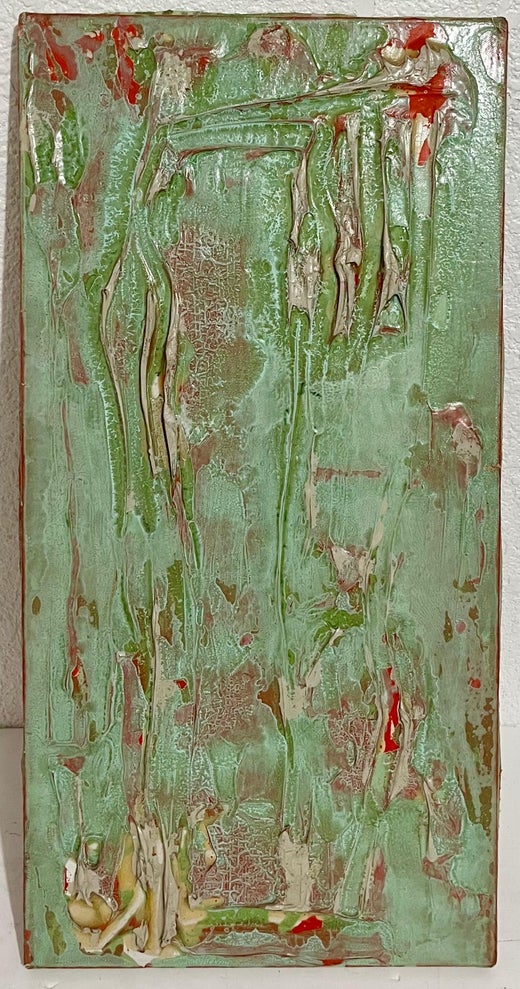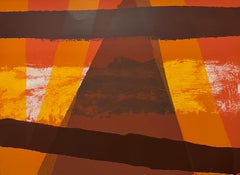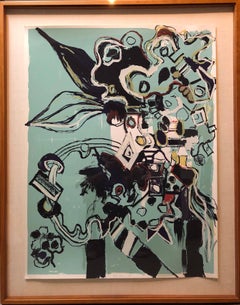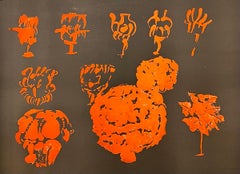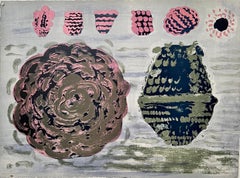Items Similar to Large Mandragora Abstract Expressionist Screenprint Lithograph Darby Bannard
Want more images or videos?
Request additional images or videos from the seller
1 of 7
Walter Darby BannardLarge Mandragora Abstract Expressionist Screenprint Lithograph Darby Bannardc.1980
c.1980
$850
£663.74
€753.45
CA$1,222.74
A$1,331.08
CHF 701.67
MX$16,117.67
NOK 8,846.25
SEK 8,284.65
DKK 5,624.28
About the Item
Walter Darby Bannard (born 1934 in New Haven, CT)
Mandragora
Silkscreen Litho print on BFK Rives art Paper. Hand signed in pencil, numbered and titled.
Walter Darby Barnard is a Professor of Art at the University of Miami, Coral Gables, Florida. His work is included in many prestigious public collections, including the Museum of Modern Art; Metropolitan Museum of Art; Whitney Museum of American Art; Guggenheim Museum; Albright-Knox Art Gallery; Aldrich Museum of Contemporary Art; Baltimore Museum of Art and the Cleveland Museum of Art.
also known as Darby Bannard, is an American abstract expressionist painter.
Bannard was born in New Haven, Connecticut and attended Phillips Exeter Academy, where he graduated in 1952. He attended Princeton University, where he befriended Frank Stella and Michael Fried, who were also interested in minimalist abstraction. This continued after graduation and eventuated in the extreme minimalism both artists engaged in around 1959 and thereafter. The first paintings from the 1959-1965 period contained few forms, as little as a single band painted around a field of color, and then developed into somewhat more complex geometric forms by the mid-60s. In the late 60s the forms dissolved into pale, atmospheric fields of color applied with rollers and paint-soaked rags. He was associated with Lyrical Abstraction, Minimalism, Formalism (art), Post-painterly Abstraction and Color Field painting.
He began using the new acrylic mediums in 1970 and his paintings evolved into colorful expanses of richly colored gels and polymers applied with squeegees and commercial floor brooms, which continues to the present.
Bannard was awarded a Guggenheim Fellowship in 1968.
Bannard’s first solo show was at the Tibor de Nagy gallery in January, 1965 and he had exhibitions there until 1970. He began showing at the Lawrence Rubin Gallery, and then in 1974 at the Knoedler Contemporary Gallery, where he showed for the next 15 years. Currently he shows at the Loretta Howard Gallery and the Berry Campbell Gallery in New York City, the Daniel Weinberg Gallery in Los Angeles and the Center for Visual Communication in Miami, Florida. He has exhibited in numerous museums and galleries nationally and internationally to the present day.
Bannard has had close to a hundred solo exhibitions, been in several hundred group shows including Six Painters (along with Dan Christensen, Ron Davis, Larry Poons, and Peter Young) “Masters of the Sixties,” Edmonton Art Gallery and Winnipeg Art Gallery, Canada, Milton Avery, Walter Darby Bannard ; Jack Bush; Anthony Caro; Helen Frankenthaler; Hans Hofmann; Morris Louis; Robert Motherwell Kenneth Noland; Jules Olitski; Larry Poons; Michael Steiner; Frank Stella and is represented in the collections of all the major New York museums and many others around the world. He is a prolific writer on art with over a hundred published essays and reviews; Bannard has taught, lectured and participated in panel discussions, and has been a Co-chair of the International Exhibitions Committee of the National Endowment for the Arts. He curated and wrote the catalog for the first comprehensive retrospective exhibition of the paintings of Hans Hofmann, at the Hirshhorn Museum in Washington, D.C.
Currently Bannard is Professor and Head of Painting of the Department of Art and Art History at the University of Miami.
In 2016, noted art historian, Barbara Rose, curated a major exhibition for Roberto Polo Gallery in Brussels, Belgium entitled, “Post-Painterly Abstraction: Belgium-USA” featuring paintings by sixteen US and Belgian artists including Walter Darby Bannard, Ed Moses and Larry Poons.
Clement Greenberg included Bannard in the exhibition Post-Painterly Abstraction at the Los Angeles County Museum of Art in 1964 an exhibition of thirty-one artists associated with these art developments. He titled it Post-Painterly Abstraction. Leading figures were Helen Frankenthaler, Morris Louis and Kenneth Noland.
Bannard was awarded a Guggenheim Fellowship in 1968. He also served as co-chair of the International Exhibitions Committee of the National Endowment for the Arts.
From 1989 to 1992, Bannard chaired the Department of Art and Art History at the University of Miami in Coral Gables, Florida, where he taught painting until his death in 2016.
Bannard was associated with modernism, lyrical abstraction, minimalism, formalism, abstraction and color field painting. His art has been exhibited in nearly a hundred solo exhibitions and several hundred group exhibitions.
Bannard's paintings from 1959 to 1965 contained few forms, as little as a single band painted around a field of color, and then developed into somewhat more complex geometric forms by the mid-1960s. The critic Phyllis Tuchman wrote about a 2015 exhibition of these works at Berry Campbell Gallery, "These colors are still radiant. And the artist’s pale palette is as uniquely personal today as it was fifty years ago. You can’t even apply a name to his hues."
In the late 1960s the forms dissolved into pale, atmospheric fields of color applied with rollers and paint-soaked rags. He began using the new acrylic mediums in 1970 and his paintings evolved into colorful expanses of richly colored gels and polymers applied with squeegees and commercial floor brooms.
Bannard wrote over a hundred reviews and essays which appeared in Artforum, Art in America, and many other publications. He curated and wrote the catalog for the first comprehensive retrospective exhibition of the paintings of Hans Hofmann at the Hirshhorn Museum in Washington, D.C. Aphorisms for Artists: 100 Ways Toward Better Art, a collection of his thoughts edited by Franklin Einspruch, was published in 2022.
Selected museum collections
Buffalo AKG Art Museum
Museum of Fine Arts, Boston
Museum of Modern Art, MoMA NYC
Philadelphia Museum of Art
Portland Art Museum
Allen Memorial Art Museum, Oberlin College, Ohio
Baltimore Museum, Maryland
Blanton Museum of Art
The University at Texas, Austin
Brooklyn Museum, New York
Centre Georges Pompidou, Paris, France
Cleveland Museum, Ohio
Dallas Museum of Fine Art, Texas
Fogg Art Museum, Cambridge, Massachusetts
Honolulu Museum, Hawaii
Indianapolis Museum of Art, Indiana
Larry Aldrich Museum, Ridgefield, Connecticut
Lowe Art Museum, Coral Gables, Florida
Metropolitan Museum of Art, New York
Museum of Fine Arts, Boston
The Museum of Fine Arts, Houston, Texas
National Gallery of Victoria, Australia
Princeton University Art Museum, New Jersey
Rose Art Museum, Brandeis University, Waltham, Massachusetts
Smithsonian American Art Museum, Washington, DC
Solomon R. Guggenheim Museum, New York
Storm King Art Center, New Windsor, New York
Whitney Museum of American Art, New York
- Creator:Walter Darby Bannard (1934, American)
- Creation Year:c.1980
- Dimensions:Height: 29.75 in (75.57 cm)Width: 42.5 in (107.95 cm)
- Medium:
- Movement & Style:
- Period:
- Condition:Minor wear, refer to photos.
- Gallery Location:Surfside, FL
- Reference Number:1stDibs: LU38215033682
Walter Darby Bannard
Bannard is known for his lyrical abstraction, minimalism, and color field paintings. Exhibition: Pasadena Art Museum 1973.
About the Seller
4.9
Platinum Seller
Premium sellers with a 4.7+ rating and 24-hour response times
Established in 1995
1stDibs seller since 2014
1,826 sales on 1stDibs
Typical response time: 1 hour
- ShippingRetrieving quote...Shipping from: Surfside, FL
- Return Policy
Authenticity Guarantee
In the unlikely event there’s an issue with an item’s authenticity, contact us within 1 year for a full refund. DetailsMoney-Back Guarantee
If your item is not as described, is damaged in transit, or does not arrive, contact us within 7 days for a full refund. Details24-Hour Cancellation
You have a 24-hour grace period in which to reconsider your purchase, with no questions asked.Vetted Professional Sellers
Our world-class sellers must adhere to strict standards for service and quality, maintaining the integrity of our listings.Price-Match Guarantee
If you find that a seller listed the same item for a lower price elsewhere, we’ll match it.Trusted Global Delivery
Our best-in-class carrier network provides specialized shipping options worldwide, including custom delivery.More From This Seller
View AllMod Abstract Expressionist Modernist Lithograph Edward Avedisian Color Field Art
By Edward Avedisian
Located in Surfside, FL
Edward Avedisian (1936-2007)
Cleo, Fur Queen, 1969
Lithograph in color on Arches wove paper.
Hand signed, dated and numbered in pencil.
Edition 100
Dimensions:
22.25 inches X 30.25...
Category
1960s Abstract Expressionist Abstract Prints
Materials
Lithograph
Large Format Modernist Abstract Lithograph Silkscreen Print Woman Artist
By Lydia Dona
Located in Surfside, FL
1982-84 Hunter College, New York (M.F.A.)
1978-80 School of Visual Arts, New York
1973-77 Bezalel Academy of Art, Jerusalem (B.F.A.)
American, born in Romania
Lives and works in New York City
Solo Exhibitions
2008 Michael Steinberg Fine Art, New York
2006 Galeria Joan Prats, Barcelona
2005 Karpio + Facchini Gallery, Miami
Jacob Karpio Galeria, San Jose (Costa Rica)
2004 Michael Steinberg Fine Art, New York
2001 Marella Arte Contemporanea, Milan
2000 Von Lintel & Nusser, New York
Galerie Von Lintel & Nusser, Munich
1998 Galerie Thomas von Lintel, Munich
1997 Galerie des Archives, Paris
1995 Galerie Samuel Lallouz, Montreal
L.A. Louver, Los Angeles
1994 Marc Jancou Gallery, London
Galerie des Archives, Paris
1993 Galerie Barbara Farber, Amsterdam
Real Art Ways, Hartford (Connecticut)
1992 Tom Cugliani Gallery, New York
Galerie Marc Jancou, Zurich
Galerie des Archives, Paris
1989 Tom Cugliani Gallery, New York
Galerie Barbara Farber, Amsterdam
Studied at bezalel from 1973 to 1977. And it was a very fascinating time because it was a highly conceptually based school. Very much influenced by Joseph Beuys, and European Conceptualism, I didn’t really like the atmosphere there that much, because it was dominated by male painters like Jörg Immendorf, Marcus Lupertz, and a few others. then came to New York to study at SVA for two years. New York in 1978 was exciting. I was very lucky to be in a class that was full of very bubbly and very energetic artists like Keith Haring, Kenny Scharf, Tim Rollins, Moira Dryer, Frank Holliday, and Tom Cugliani (who later became one of my dealers).The eighties were dominated largely by Neo-Expressionist paintings. There were Germans, such as Baselitz, Kiefer, Richter, Penck, and the Italians, Clemente, Chia, Cucchi, Palladino as well as Schnabel, Fischl, Basquiat, Salle, and many others, but all of their paintings were figuratively based. But below the popular consent, there was a group of painters who were working more in the vein of what Stephen Westfall referred to as “Neo-Surrealism,” including George Condo, Jeffrey Wasserman, Kenneth Scharf, David Humphrey. However, I felt that Carroll Dunham and you were the only two painters who seemed to be less interested in the kind of narrative, lyrical, or let’s say, stationary composition. He belongs to the generation of Terry Winters, Elizabeth Murray, David Reed and Jonathan Lasker but in some strange way, if we’re looking back to the mid-eighties, we have to include New Image painters like Susan Rothenberg, Neil Jenney, and Robert Moskowitz who were working in between the figure and abstraction with a kind of condensation and compression, in relationship, lets say, to cartoon imagery. There are artists like Jeff Koons, or even Damien Hirst who took the Duchampian aspect and brought it into the continuity of his readymade. But for me, I see no difference between the crack in “Large Glass” and the drips in Jackson Pollock’s paintings. There was something that I felt in my own equation of the continuity between Paul Klee, Duchamp, Picabia, and, oddly enough, Clyfford Still.
What essentially is important is how different artists carry on a dialogue among themselves so that they can all keep their work vital. Whether from the abstract paintings of Richmond Burton, Fabian Marcaccio extending the borders of his paintings on to the wall, or Cady Noland’s early scattered installation, my own pre-occupation with machinery, urban environment, and the Duchampian models has always materialized in relationship to other forms of art making.
Selected Group Exhibitions:
2014 Drawing on Difference: An Ambition by Saul Ostrow and Lidija
Slavkovic, Studio Vendome Gallery, New York.
2013 Drawing on Habit: An Ambition by Saul Ostrow and Lidija Slavkovic,
South Carlton Beach and The Betsy-South Beach Exhibition Programs,
Art Basel, Miami Beach.
2013 Imprinted Pictures: Lydia Dona...
Category
1980s Abstract Expressionist Abstract Prints
Materials
Lithograph, Screen
Pietro Consagra Italian Mod Abstract Expressionist Forma Art Informel Lithograph
By Pietro Consagra
Located in Surfside, FL
Pietro Consagra (Italian, 1920-2005).
Hand signed in pencil and numbered limited edition color lithograph on Magnani paper.
Embossed stamp with limited edition numbers in pencil to lower left, and having artist pencil signature to lower right.
(from a limited edition of 80 with 15 artist's proofs)
Published by Stamperia 2RC, Rome Italy and Marlborough Gallery, Rome, Italy.
Abstract Modernist work in colors, produced in the style of the Forma art movement of Postwar Italy, of which the artist was a prominent member.
Pietro Consagra (1920 – 2005) was an Italian Post war artist working in painting, printmaking and sculpture. In 1947 he was among the founding members of the Forma 1 group of artists, proponents of structured abstraction. (similar to the Art Informel and Art Brut in France and the Brutalist artists)
Consagra was born on 6 October 1920 in Mazara del Vallo, in the province of Trapani in south-western Sicily, to Luigi Consagra and Maria Lentini. From 1931 he enrolled in a trade school for sailors, studying first to become a mechanic, and later to become a captain. In 1938 he moved to Palermo, where he enrolled in the liceo artistico; despite an attack of tuberculosis, he graduated in 1941, and in the same year signed up at the Accademia di Belle Arti, where he studied sculpture under Archimede Campini. After the Invasion of Sicily and the Allied occupation of Palermo in 1943, Consagra found work as a caricaturist for the American Red Cross club of the city; he also joined the Italian Communist Party. Early in 1944, armed with a letter of introduction from an American officer, he travelled to Rome. There he came into contact with the Sicilian artist Concetto Maugeri, and through him with Renato Guttuso, who was also Sicilian and who introduced him to the intellectual life of the city and to other postwar artists such as Leoncillo Leonardi, Mario Mafai and Giulio Turcato. Consagra signed up at the Accademia di Belle Arti di Roma in September 1944 and studied sculpture there under Michele Guerrisi, but left before completing his diploma.
In 1947, with Carla Accardi, Ugo Attardi, Piero Dorazio, Mino Guerrini, Achille Perilli, Antonio Sanfilippo and Giulio Turcato, Consagra started the artist's group Forma 1, which advocated both Marxism and structured abstraction.
Steadily Consagra's work began to find an audience. Working primarily in metal, and later in marble and wood, his thin, roughly carved reliefs, began to be collected by Peggy Guggenheim and other important patrons of the arts. He showed at the Venice Biennale eleven times between 1950 and 1993, and in 1960 won the sculpture prize at the exhibition. During the 1960s he was associated with the Continuità group, an offshoot of Forma I, and in 1967 taught at the School of Arts in Minneapolis. Large commissions allowed him to begin working on a more monumental scale, and works of his were installed in the courtyard of the Foreign Ministry in Rome and in the European Parliament, Strasbourg. His work is found in the collections of The Tate Gallery, London, in Museo Cantonale d'Arte of Lugano and the Museum of Modern Art, Paris, and the National Gallery of Art in Washington, D.C..
Consagra returned to Sicily where he sculpted a number of significant works during the 1980s. With Senator Ludovico Corrao, he helped created an open-air museum in the new town of Gibellina, after the older town had been destroyed in the earthquake of 1968. Consagra designed the gates to the town's entrance, the building named "Meeting" and the gates to the cemetery, where he was later buried.
In 1952 Consagra published La necessità della scultura ("the need for sculpture"), a response to the essay La scultura lingua morta ("sculpture, a dead language"), published in 1945 by Arturo Martini. Other works include L'agguato c'è ("the snare exists", 1960), and La città frontale ("the frontal city", 1969). His autobiography, Vita Mia, was published by Feltrinelli in 1980. In 1989 a substantial retrospective exhibition of work by Consagra was shown at the Galleria Nazionale d'Arte Moderna in Rome; in 1993 a permanent exhibition of his work was installed there. In 1991 his work was shown in the Hermitage Museum in St. Petersburg. In 2002 the Galerie der Stadt Stuttgart opened a permanent exhibition of his work. He was one of ten artists invited by Giovanni Carandente, along with David Smith, Alexander Calder, Arnaldo Pomodoro, Lynn Chadwick, and Beverly Pepper, to fabricate works in Italsider factories in Italy for an outdoor exhibition, "Sculture nella città", held in Spoleto during the summer of 1962. He was included in the The 1962 International Prize for Sculpture the jury included Argan, Romero Brest and James Johnson Sweeney the former director of the Solomon R. Guggenheim Museum in New York. The participants included Louise Nevelson and John Chamberlain for the United States; Lygia Clark for Brazil; Pietro Consagra, Lucio Fontana, Nino Franchina, and Gió Pomodoro for Italy; Pablo Serrano for Spain; and Eduardo Paolozzi, William Turnbull, and Kenneth Armitage for England. Gyula Kosice, Noemí Gerstein, Julio Gero, Naum Knop...
Category
1960s Abstract Expressionist Abstract Prints
Materials
Lithograph
Pietro Consagra Italian Mod Abstract Expressionist Forma Art Informel Lithograph
By Pietro Consagra
Located in Surfside, FL
Pietro Consagra (Italian, 1920-2005).
Hand signed in pencil and numbered limited edition color lithograph on Magnani paper.
Embossed stamp with limited edition numbers in pencil to lower left, and having artist pencil signature to lower right.
(from a limited edition of 80 with 15 artist's proofs)
Published by Stamperia 2RC, Rome Italy and Marlborough Gallery, Rome, Italy.
Abstract Modernist work in colors, produced in the style of the Forma art movement of Postwar Italy, of which the artist was a prominent member.
Pietro Consagra (1920 – 2005) was an Italian Post war artist working in painting, printmaking and sculpture. In 1947 he was among the founding members of the Forma 1 group of artists, proponents of structured abstraction. (similar to the Art Informel and Art Brut in France and the Brutalist artists)
Consagra was born on 6 October 1920 in Mazara del Vallo, in the province of Trapani in south-western Sicily, to Luigi Consagra and Maria Lentini. From 1931 he enrolled in a trade school for sailors, studying first to become a mechanic, and later to become a captain. In 1938 he moved to Palermo, where he enrolled in the liceo artistico; despite an attack of tuberculosis, he graduated in 1941, and in the same year signed up at the Accademia di Belle Arti, where he studied sculpture under Archimede Campini. After the Invasion of Sicily and the Allied occupation of Palermo in 1943, Consagra found work as a caricaturist for the American Red Cross club of the city; he also joined the Italian Communist Party. Early in 1944, armed with a letter of introduction from an American officer, he travelled to Rome. There he came into contact with the Sicilian artist Concetto Maugeri, and through him with Renato Guttuso, who was also Sicilian and who introduced him to the intellectual life of the city and to other postwar artists such as Leoncillo Leonardi, Mario Mafai and Giulio Turcato. Consagra signed up at the Accademia di Belle Arti di Roma in September 1944 and studied sculpture there under Michele Guerrisi, but left before completing his diploma.
In 1947, with Carla Accardi, Ugo Attardi, Piero Dorazio, Mino Guerrini, Achille Perilli, Antonio Sanfilippo and Giulio Turcato, Consagra started the artist's group Forma 1, which advocated both Marxism and structured abstraction.
Steadily Consagra's work began to find an audience. Working primarily in metal, and later in marble and wood, his thin, roughly carved reliefs, began to be collected by Peggy Guggenheim and other important patrons of the arts. He showed at the Venice Biennale eleven times between 1950 and 1993, and in 1960 won the sculpture prize at the exhibition. During the 1960s he was associated with the Continuità group, an offshoot of Forma I, and in 1967 taught at the School of Arts in Minneapolis. Large commissions allowed him to begin working on a more monumental scale, and works of his were installed in the courtyard of the Foreign Ministry in Rome and in the European Parliament, Strasbourg. His work is found in the collections of The Tate Gallery, London, in Museo Cantonale d'Arte of Lugano and the Museum of Modern Art, Paris, and the National Gallery of Art in Washington, D.C..
Consagra returned to Sicily where he sculpted a number of significant works during the 1980s. With Senator Ludovico Corrao, he helped created an open-air museum in the new town of Gibellina, after the older town had been destroyed in the earthquake of 1968. Consagra designed the gates to the town's entrance, the building named "Meeting" and the gates to the cemetery, where he was later buried.
In 1952 Consagra published La necessità della scultura ("the need for sculpture"), a response to the essay La scultura lingua morta ("sculpture, a dead language"), published in 1945 by Arturo Martini. Other works include L'agguato c'è ("the snare exists", 1960), and La città frontale ("the frontal city", 1969). His autobiography, Vita Mia, was published by Feltrinelli in 1980. In 1989 a substantial retrospective exhibition of work by Consagra was shown at the Galleria Nazionale d'Arte Moderna in Rome; in 1993 a permanent exhibition of his work was installed there. In 1991 his work was shown in the Hermitage Museum in St. Petersburg. In 2002 the Galerie der Stadt Stuttgart opened a permanent exhibition of his work. He was one of ten artists invited by Giovanni Carandente, along with David Smith, Alexander Calder, Arnaldo Pomodoro, Lynn Chadwick, and Beverly Pepper, to fabricate works in Italsider factories in Italy for an outdoor exhibition, "Sculture nella città", held in Spoleto during the summer of 1962. He was included in the The 1962 International Prize for Sculpture the jury included Argan, Romero Brest and James Johnson Sweeney the former director of the Solomon R. Guggenheim Museum in New York. The participants included Louise Nevelson and John Chamberlain for the United States; Lygia Clark for Brazil; Pietro Consagra, Lucio Fontana, Nino Franchina, and Gió Pomodoro for Italy; Pablo Serrano for Spain; and Eduardo Paolozzi, William Turnbull, and Kenneth Armitage for England. Gyula Kosice, Noemí Gerstein, Julio Gero, Naum Knop...
Category
1960s Abstract Expressionist Abstract Prints
Materials
Lithograph
Pietro Consagra Italian Mod Abstract Expressionist Forma Brutalist Lithograph
By Pietro Consagra
Located in Surfside, FL
Pietro Consagra (Italian, 1920-2005).
Hand signed in pencil and numbered limited edition color lithograph on Magnani paper.
Embossed stamp with limited edition numbers in pencil to lower left, and having artist pencil signature to lower right.
(from a limited edition of 80 with 15 artist's proofs)
Published by Stamperia 2RC, Rome Italy and Marlborough Gallery, Rome, Italy.
Abstract Modernist work in colors, produced in the style of the Forma art movement of Postwar Italy, of which the artist was a prominent member.
Pietro Consagra (1920 – 2005) was an Italian Post war artist working in painting, printmaking and sculpture. In 1947 he was among the founding members of the Forma 1 group of artists, proponents of structured abstraction.
Consagra was born on 6 October 1920 in Mazara del Vallo, in the province of Trapani in south-western Sicily, to Luigi Consagra and Maria Lentini. From 1931 he enrolled in a trade school for sailors, studying first to become a mechanic, and later to become a captain. In 1938 he moved to Palermo, where he enrolled in the liceo artistico; despite an attack of tuberculosis, he graduated in 1941, and in the same year signed up at the Accademia di Belle Arti, where he studied sculpture under Archimede Campini. After the Invasion of Sicily and the Allied occupation of Palermo in 1943, Consagra found work as a caricaturist for the American Red Cross club of the city; he also joined the Italian Communist Party. Early in 1944, armed with a letter of introduction from an American officer, he travelled to Rome. There he came into contact with the Sicilian artist Concetto Maugeri, and through him with Renato Guttuso, who was also Sicilian and who introduced him to the intellectual life of the city and to other postwar artists such as Leoncillo Leonardi, Mario Mafai and Giulio Turcato. Consagra signed up at the Accademia di Belle Arti di Roma in September 1944 and studied sculpture there under Michele Guerrisi, but left before completing his diploma.
In 1947, with Carla Accardi, Ugo Attardi, Piero Dorazio, Mino Guerrini, Achille Perilli, Antonio Sanfilippo and Giulio Turcato, Consagra started the artist's group Forma 1, which advocated both Marxism and structured abstraction.
Steadily Consagra's work began to find an audience. Working primarily in metal, and later in marble and wood, his thin, roughly carved reliefs, began to be collected by Peggy Guggenheim and other important patrons of the arts. He showed at the Venice Biennale eleven times between 1950 and 1993, and in 1960 won the sculpture prize at the exhibition. During the 1960s he was associated with the Continuità group, an offshoot of Forma I, and in 1967 taught at the School of Arts in Minneapolis. Large commissions allowed him to begin working on a more monumental scale, and works of his were installed in the courtyard of the Foreign Ministry in Rome and in the European Parliament, Strasbourg. His work is found in the collections of The Tate Gallery, London, in Museo Cantonale d'Arte of Lugano and the Museum of Modern Art, Paris, and the National Gallery of Art in Washington, D.C..
Consagra returned to Sicily where he sculpted a number of significant works during the 1980s. With Senator Ludovico Corrao, he helped created an open-air museum in the new town of Gibellina, after the older town had been destroyed in the earthquake of 1968. Consagra designed the gates to the town's entrance, the building named "Meeting" and the gates to the cemetery, where he was later buried.
In 1952 Consagra published La necessità della scultura ("the need for sculpture"), a response to the essay La scultura lingua morta ("sculpture, a dead language"), published in 1945 by Arturo Martini. Other works include L'agguato c'è ("the snare exists", 1960), and La città frontale ("the frontal city", 1969). His autobiography, Vita Mia, was published by Feltrinelli in 1980. In 1989 a substantial retrospective exhibition of work by Consagra was shown at the Galleria Nazionale d'Arte Moderna in Rome; in 1993 a permanent exhibition of his work was installed there. In 1991 his work was shown in the Hermitage Museum in St. Petersburg. In 2002 the Galerie der Stadt Stuttgart opened a permanent exhibition of his work. He was one of ten artists invited by Giovanni Carandente, along with David Smith, Alexander Calder, Arnaldo Pomodoro, Lynn Chadwick, and Beverly Pepper, to fabricate works in Italsider factories in Italy for an outdoor exhibition, "Sculture nella città", held in Spoleto during the summer of 1962. He was included in the The 1962 International Prize for Sculpture the jury included Argan, Romero Brest and James Johnson Sweeney the former director of the Solomon R. Guggenheim Museum in New York. The participants included Louise Nevelson and John Chamberlain for the United States; Lygia Clark for Brazil; Pietro Consagra, Lucio Fontana, Nino Franchina, and Gió Pomodoro for Italy; Pablo Serrano for Spain; and Eduardo Paolozzi, William Turnbull, and Kenneth Armitage for England. Gyula Kosice, Noemí Gerstein, Julio Gero, Naum Knop...
Category
1960s Abstract Expressionist Abstract Prints
Materials
Lithograph
Pietro Consagra Italian Mod Abstract Expressionist Forma Brutalist Lithograph
By Pietro Consagra
Located in Surfside, FL
Pietro Consagra (Italian, 1920-2005).
Hand signed in pencil and numbered limited edition color lithograph on Magnani paper.
Embossed stamp with limited edition numbers in pencil to lower left, and having artist pencil signature to lower right.
(from a limited edition of 80 with 15 artist's proofs)
Published by Stamperia 2RC, Rome Italy and Marlborough Gallery, Rome, Italy.
Abstract Modernist work in colors, produced in the style of the Forma art movement of Postwar Italy, of which the artist was a prominent member.
Pietro Consagra (1920 – 2005) was an Italian Post war artist working in painting, printmaking and sculpture. In 1947 he was among the founding members of the Forma 1 group of artists, proponents of structured abstraction.
Consagra was born on 6 October 1920 in Mazara del Vallo, in the province of Trapani in south-western Sicily, to Luigi Consagra and Maria Lentini. From 1931 he enrolled in a trade school for sailors, studying first to become a mechanic, and later to become a captain. In 1938 he moved to Palermo, where he enrolled in the liceo artistico; despite an attack of tuberculosis, he graduated in 1941, and in the same year signed up at the Accademia di Belle Arti, where he studied sculpture under Archimede Campini. After the Invasion of Sicily and the Allied occupation of Palermo in 1943, Consagra found work as a caricaturist for the American Red Cross club of the city; he also joined the Italian Communist Party. Early in 1944, armed with a letter of introduction from an American officer, he travelled to Rome. There he came into contact with the Sicilian artist Concetto Maugeri, and through him with Renato Guttuso, who was also Sicilian and who introduced him to the intellectual life of the city and to other postwar artists such as Leoncillo Leonardi, Mario Mafai and Giulio Turcato. Consagra signed up at the Accademia di Belle Arti di Roma in September 1944 and studied sculpture there under Michele Guerrisi, but left before completing his diploma.
In 1947, with Carla Accardi, Ugo Attardi, Piero Dorazio, Mino Guerrini, Achille Perilli, Antonio Sanfilippo and Giulio Turcato, Consagra started the artist's group Forma 1, which advocated both Marxism and structured abstraction.
Steadily Consagra's work began to find an audience. Working primarily in metal, and later in marble and wood, his thin, roughly carved reliefs, began to be collected by Peggy Guggenheim and other important patrons of the arts. He showed at the Venice Biennale eleven times between 1950 and 1993, and in 1960 won the sculpture prize at the exhibition. During the 1960s he was associated with the Continuità group, an offshoot of Forma I, and in 1967 taught at the School of Arts in Minneapolis. Large commissions allowed him to begin working on a more monumental scale, and works of his were installed in the courtyard of the Foreign Ministry in Rome and in the European Parliament, Strasbourg. His work is found in the collections of The Tate Gallery, London, in Museo Cantonale d'Arte of Lugano and the Museum of Modern Art, Paris, and the National Gallery of Art in Washington, D.C..
Consagra returned to Sicily where he sculpted a number of significant works during the 1980s. With Senator Ludovico Corrao, he helped created an open-air museum in the new town of Gibellina, after the older town had been destroyed in the earthquake of 1968. Consagra designed the gates to the town's entrance, the building named "Meeting" and the gates to the cemetery, where he was later buried.
In 1952 Consagra published La necessità della scultura ("the need for sculpture"), a response to the essay La scultura lingua morta ("sculpture, a dead language"), published in 1945 by Arturo Martini. Other works include L'agguato c'è ("the snare exists", 1960), and La città frontale ("the frontal city", 1969). His autobiography, Vita Mia, was published by Feltrinelli in 1980. In 1989 a substantial retrospective exhibition of work by Consagra was shown at the Galleria Nazionale d'Arte Moderna in Rome; in 1993 a permanent exhibition of his work was installed there. In 1991 his work was shown in the Hermitage Museum in St. Petersburg. In 2002 the Galerie der Stadt Stuttgart opened a permanent exhibition of his work. He was one of ten artists invited by Giovanni Carandente, along with David Smith, Alexander Calder, Arnaldo Pomodoro, Lynn Chadwick, and Beverly Pepper, to fabricate works in Italsider factories in Italy for an outdoor exhibition, "Sculture nella città", held in Spoleto during the summer of 1962. He was included in the The 1962 International Prize for Sculpture the jury included Argan, Romero Brest and James Johnson Sweeney the former director of the Solomon R. Guggenheim Museum in New York. The participants included Louise Nevelson and John Chamberlain for the United States; Lygia Clark for Brazil; Pietro Consagra, Lucio Fontana, Nino Franchina, and Gió Pomodoro for Italy; Pablo Serrano for Spain; and Eduardo Paolozzi, William Turnbull, and Kenneth Armitage for England. Gyula Kosice, Noemí Gerstein, Julio Gero, Naum Knop...
Category
1960s Abstract Expressionist Abstract Prints
Materials
Lithograph
You May Also Like
Large Abstract Expressionist Silkscreen by Michael Steiner
By Michael Steiner
Located in Long Island City, NY
Abstract expressionist print by American artist Michael Steiner, who is most commonly known for his large scale sculptures.
Michael Steiner, American (1945)
Date: 1979
Screenprint,...
Category
1970s Abstract Expressionist Abstract Prints
Materials
Screen
12 Bottom, Large Abstract Expressionist Screenprint by Darryl Hughto
By Darryl Hughto
Located in Long Island City, NY
Artist: Darryl Hughto, American (1943 - )
Title: 12 Bottom
Year: 1982
Medium: Screenprint, signed and numbered in pencil
Edition: AP 9
Size: 42 x 30 in. (106.68 x 76.2 cm)
Category
1980s Abstract Abstract Prints
Materials
Screen
12 Bottom, Large Abstract Expressionist Screenprint by Darryl Hughto
By Darryl Hughto
Located in Long Island City, NY
Artist: Darryl Hughto, American (1943 - )
Title: 12 Bottom
Year: 1982
Medium: Screenprint, signed and numbered in pencil
Edition: AP
Size: 42 x 30 in. (106.68 x 76.2 cm)
Category
1980s Abstract Expressionist Abstract Prints
Materials
Screen
Untitled. Very large original screen print
By Robert Natkin
Located in San Francisco, CA
This artwork "Untitled" 1986 is a large original color screen print on Wove paper by noted American abstract expressionist artist Robert Natkin, 1930-2010. IOt is hand signed, dated ...
Category
Late 20th Century Abstract Expressionist Abstract Prints
Materials
Screen
Sicilian Magician, Abstract Screenprint by Walter Darby Bannard
By Walter Darby Bannard
Located in Long Island City, NY
Sicilian Magician
Walter Darby Bannard, American (1934–2016)
Date: 1980
Screenprint, signed, numbered, and titled in pencil
Edition of 99/100
Image Size: 20 x 30 inches
Size: 25 x 38...
Category
1980s Abstract Expressionist Abstract Prints
Materials
Screen
Edo, Abstract Expressionist Screenprint by Dan Christensen
By Dan Christensen
Located in Long Island City, NY
Dan Christensen, American (1942 - 2007) - Edo, Year: circa 1981, Medium: Screenprint, signed, titled and numbered in pencil, Edition: HC, Image Size: 38.5 x 27 inches, Size: 42 ...
Category
1980s Abstract Expressionist Abstract Prints
Materials
Screen
More Ways To Browse
Paintings By Belgian Artists
George Jack For Morris Co
Stella Michaels
Philip Guston Prints
Picasso Affiches
Picasso Chat
Pierre Gaillardot
Quelques Fleurs Pour Des Amis
Rauschenberg Collage
Robert Barry
Robert Fisher
Robert Indiana Two
Robert Motherwell Africa
Robert Motherwell Octavio Paz
Roy Lichtenstein Plate
Ruth Alexander
Sam Francis Monotype
Steinberg Print Signed
